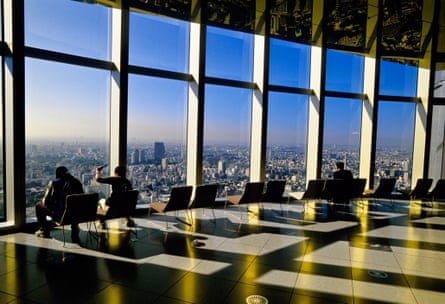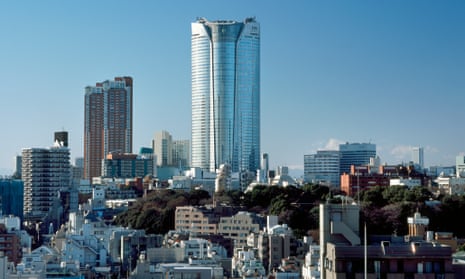When the late Tokyo property tycoon Minoru Mori completed construction of Roppongi Hills in 2003, it was hailed as a technological wonder – a huge, sprawling hodgepodge of residential, commercial, leisure and retail functions that performed as if it were a self-contained neighbourhood. And it was, though perhaps not in the way its designers imagined.
The layout was almost perversely illogical: 724,000 square metres of floor space distributed among four distinct high-rises and a warren of multi-level passages that could have been designed by Magritte. The joke about Roppongi Hills is that once inside, no one has ever been able to figure out how to get from point A to point B and back again – even with a map.
Whether intended or not, this complex mimics the maze-like quality of many old Tokyo neighbourhoods. Until the end of the second world war, the city had the unfortunate habit of burning down every couple of years (in fact, local firefighting brigades were traditionally made up of carpenters, thus providing an historical rationalisation for Tokyo’s infamous “scrap-and-build” reputation).
Since the war, the city seems to have been transforming itself on an almost daily basis, resisting any attempts at urban planning owing to the makeshift nature of its neighbourhoods, a laissez-faire attitude toward development, and a penchant for the new. In this, Roppongi Hills was no different.
The neighbourhood the complex replaced was a jumble of miscellaneous structures delineated by several main thoroughfares and the studios of a major commercial broadcaster. By the 1960s, the area contained five nine-storey apartment buildings run by the national housing authority, but mostly it was made up of closely packed wooden houses arranged along twisting streets that were so narrow they couldn’t accommodate fire trucks – and which only had one exit point.

The Roppongi neighbourhood is in the heart of the Yamanote, an area of the city centre ringed by the railway line – what Tokyo historian Edward Seidensticker called the “high city”, where the “proper people” lived. Except that Roppongi wasn’t considered proper. During the pre-modern era and blessed with abundant ground water, the area was populated by samurai warriors who supplemented their measly sinecures by raising goldfish. The tradition continued: the first head of the Roppongi Hills residents’ association, Tamotsu Hara, used to breed goldfish himself before his house was condemned and he moved to a comfortable corner unit on the 41st floor.
Before the war, Roppongi was home to the Japanese military; afterwards, the Americans used it for a base that outlasted the occupation. By the high-powered 1980s it had became Tokyo’s designated exotic demimonde, famous for bars and discos frequented by foreign residents and servicemen on the prowl. It was never as respectable as the nearby neighbourhoods, but it was on the edge of the commercial district that Minoru Mori’s family was quickly filling up with tall office buildings. In 1986, he gained permission from the Tokyo prefectural government to redevelop Roppongi, of which Kohn Pedersen Fox Associates was the master-planner of the scheme – the biggest such project in the city’s history.
It took Mori 17 years to negotiate the title transfers. About 400 households were promised condominiums in the towers to be constructed on the land they were being asked to give up, but only 161 actually took up the offer. During the extreme “bubble” period of the late 1980s, property values in Roppongi skyrocketed – so even though the owners could sell their land for huge profits, the new condos would cost them even more. Moreover, the management fees of more than 60,000 yen (£320) a month were beyond the means of most of these families.
Japanese city planners have always been interested in the self-contained community. In the 1960s and 70s, “new towns” designed by the central housing authority sprung up in the suburbs of the country’s major cities. Modern apartment blocks and single-family houses would be within walking distance of shopping and leisure facilities – and, most importantly, work places. Though popular, these developments never attracted the businesses that would have made them true “towns”, so salarymen residents ended up commuting into the city.

With Roppongi’s central location, however, the job issue took care of itself. Moreover, it alleviated some of the problems associated with modern city living by mixing in some suburban elements. A quarter of the compex’s total footprint is made up of parks, and the buildings’ roofs all possess real vegetable gardens. One even has a rice paddy. Consequently, the average outdoor temperature within its borders is 2-to-3 degrees cooler than that of the surrounding neighbourhoods, thus addressing the urban heat island phenomenon.
The complex also has its own gas turbine that reduces energy usage by 20% and carbon emissions by 27%. It is is self-sufficient in the event of power outages – essential for a facility that relies on elevators – and has 13 rainwater collection points; waste water is purified and reused within the complex. All refuse is recycled, and solar panels provide lighting with the surplus stored in batteries.
These features make Roppongi Hills not only environmentally responsible but also fairly disaster-proof – a model for how to live in a city that everyone knows is going to be hit by a major earthquake one of these days. The kind of densely concentrated wooden neighbourhood that Roppongi used to be – and the kind that still houses 20% of Tokyo’s population – will crumble and ignite in such a quake. But Roppongi Hills has set an example that has been followed throughout the city in a rush to build new high-rise towers that aim to be self-contained, self-sufficient and state-of-the-art in terms of withstanding disasters.
While the temblor which devastated the northeastern region of Japan in 2011 slowed this “tower mansion” boom slightly, Tokyo is one of the few places that continues to attract new residents as the country’s overall population dwindles. Many people question the wisdom of this vertical orientation to buildings, but in Tokyo (and most of Japan) there’s no place to go but up.
Not everyone can afford this green, disaster-resilient lifestyle, of course. In 2003 when Roppongi Hills was completed, the complex immediately became identified with Japan’s version of the 1%, and its success spawned two similar luxury complexes: Tokyo Midtown, a few blocks to the east, and Toranomon Hills.
When Roppongi Hills opened, high-profile IT and finance companies moved into its office spaces. Some of the wealthiest people in the country have lived in its apartments, including Takafumi Horie, founder and former CEO of Livedoor, the hugely controversial internet services firm.
Horie subsequently spent several years in jail for securities fraud, but his reputation as an iconoclast endures and is informed by the image attached to Roppongi Hills – a place that goes beyond the conventional notion of what a high-rise complex is for, while maintaining the unique “jerry-built” quality of the Tokyo landscape. The main difference, though, is that this complex has been designed to last a lot longer.
- Which other buildings in the world tell stories about urban history? Share your own pictures and descriptions with GuardianWitness, on Twitter and Instagram using #hoc50 or let us know suggestions in the comments below

Comments (…)
Sign in or create your Guardian account to join the discussion